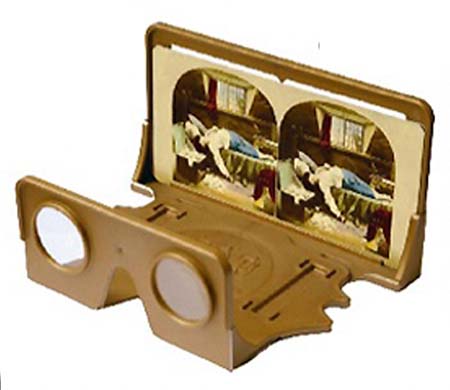THE BOOKSELLER
16 May 2014 by ANNA JAMES
– “introducing a new fine-art publisher with a passion for 3-D”

The guitarist of one of Britain’s most successful musical exports turns his focus to publishing his passion: stereoscopic photographs. Brian May is publishing a book of Victorian stereoscopic 3D images in collaboration with Tate Britain under his imprint the London Stereoscopic Company (LSC).
May became entranced with stereoscopy after collecting cards from a Weetabix box as a child. “I always thought it was complete magic. I could never understand why the whole world wasn’t making 3D pictures,” May said. “Why bother to make 2D pictures when you can make them 3D?”
A 40-year interest in stereoscopy has led to May refunding the LSC in order to publish new stereoscopic titles. The LSC traded form 1854 to 1922, selling over a million stereo viewers. May has been working with Robin Rees of Canopus Publishing – “who, like me, values quality much more than business” – to develop the imprint.
Last year it realised Diableries (£40), which has sold 3,076 copies for £88,560 through Nielsen BookScan. October will bring The Poor Man’s Picture Gallery (£40), which explores the Victorian trend of producing staged 3D photo versions of popular paintings to make them more accessible. May said: “It’s one of those areas that has been swept under the carpet for the past 150 years, so it’s exciting to be able to delve into it and present it as a book that is enjoyable in the same way as the material would have been for the Victorians.”
Each book comes with an “Owl” viewer (pictured), designed and heavily subsidised by May, “to keep the cost down, to make sure it’s accessible – I don’t think this is something I’m ever going to make money out of.” The books are published at the highest resolute possible. May explained: “It has to be a lot better than even the best art book because effectively you’re looking at these books through magnifying glasses.”

Talking about the experience of reviving a publishing imprint, May said: “I wanted an outlet for my own research but once we established the format and the mechanisms of printing at high enough quality. I realised I could be a channel for other people’s work. So now we’re launching the LSC as a serious publisher and as an imprint. It’s very exciting.”
LSC will republish a book about Scottish landscape photographer George Washington Wilson by Professor Robert Taylor from De Montfort University. “The book was originally rushed out on a very low budget so we’re going to restore that book. It’s a beautiful book and it make me happy to be able to bring back something that has been out of print for years.”
May is also working on an astrology collaboration collecting 3D images of objects it he solar system, with a stereoscopic Queen book on the horizon as well. “I’ve already published two series of Queen stereo cards – I was able to do that because all through the Queen touring years I carried a stereoscopic camera. I have a great collection of stereoscopic photographs from the glory days of Queen, including a series taken at the filming of the ‘Radio Ga Ga’ video, which I think people are going to really enjoy.”
On the future of publishing, May described visiting the London Book Fair this year: “I had the impression that books were on the way out and nobody read them anymore, that it was a dying art. [At LBF] I saw people so excited about books and thousand of new publications and I found it very heartening.”
Comparing publishing to the music business, May said: “In a sense it’s healthy that people can now make records in their bedrooms. Record companies still exist but the playing field has altered, it’s woken up a lot of people. The internet has brought transparency, which is a huge step forward. I think the world is changing . . . we just have to adjust.”
READ MORE: THE BOOKSELLER